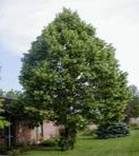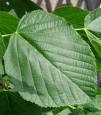| Kingdom | Plantae |
| Unranked | Angiosperms |
| Unranked | Eudicots |
| Order | Malvales |
| Family | Malvaceae |
| Genus | Tilia |
| Species | T. americana |
| Binomial name | Tilia americana |
Other Common Names:
The other common names for the linden tree are Basswood, whitewood, bast tree, black lime tree, American lin tree, American lime tree, beetree, daddynut tree, monkeynut tree, whistlewood, white lind, red basswood, yellow basswood and wickup.
History
Linden and lime are the names various species of Tilia go by in Europe. Whitewood alludes to the pale colour of both the heartwood and sapwood. Basswood is called bee tree in some areas because the flowers of Tilia trees draw bees in droves.

Description
The Linden tree is pyramidal as a young tree, and matures into an upright tree with a pillar-like trunk and a canopy-like top. Young trees are columnar; mature trees develop a broad, spreading crown. The trunk is straight, free of branches for a considerable height, and the bark is light brown and smooth, becoming darker and deeply furrowed on older trees.



Range
This tree is a native to eastern North America. Basswood ranges from south-western New Brunswick and New England west in Quebec and Ontario to the southeast corner of Manitoba; south through eastern North Dakota, South Dakota, Nebraska, and Kansas to north-eastern Oklahoma; east to northern Arkansas, Tennessee, western North Carolina; and northeast to New Jersey
Habitat
Basswood grows in moist mixed hardwood forests, often associated with maples, oaks, and ashes. It is commonly seen in richly wooded areas and open forests and is cultivated in parkland and gentlemen's gardens. Linden tree thrives best in sun, moist, well drained fertile soil; tolerates dry soil and clay but not wet sites and the soil should be kept mulched.
Cultivation
This tree transplants readily and does best in deep, rich, moist, well-drained soils with full sun or partial shade. Never plant the American linden over a parking area, such as a driveway; the sticky nectar that drips from the flowers can damage car paint. Much of the seed produced in Britain is not viable, cut a few seedcases open to see if there is a seed inside. If possible, obtain fresh seed that is ripe but has not as yet developed a hard seed coat and sow it immediately in a cold frame. It may germinate in the following spring though it could take 18 months. Stored seed can be very slow to germinate. It has a hard seed coat, embryo dormancy and a hard coat on the pericarp. All these factors mean that the seed may take up to 8 years to germinate. One way of shortening this time is to stratify the seed for 5 months at high temperatures (10°c at night, up to 30°c by day) and then 5 months cold stratification. When they are large enough to handle, prick the seedlings out into individual pots and grow them on in the greenhouse for their first winter. Plant them out into their permanent positions in late spring or early summer, after the last expected frosts. Layering in spring just before the leaves unfurl and it takes 1 - 3 years. Suckers, when formed, can be removed with as much root as possible during the dormant season and replanted immediately.
Flowering Season
The yellow fragrant flowers growing from a wing-like stalk are in bloom from June to August.
Pests and Diseases
Fire wounding of basswood increases susceptibility to butt rot: of trees with basal fire wounds. Trees are usually attacked by aphids which cover the ground and the leaves with sticky honeydew. Plants in this genus are notably resistant to honey fungus.
Parts Used


Flowers, young leaves and the inner bark of the linden tree are the most commonly used parts for its commercial and medicinal purposes.
Medicinal Applications


• Linden tree in treating headaches and restlessness.
• Lime flowers (from Linden trees) are used in tea, and to treat colds, coughs, fevers, infections, high blood pressure, and as a diuretic, antispasmodic, and sedative.
• Flowers contain flavanoids which act as antioxidants, and tannins that act as an astringent.
• Linden flower tea contains mucilage that coat the throat to soothe inflammation and irritation.
• The inner bark is used as a tea for lung ailments, heartburn, and weak stomach. Also used inner bark as a poultice to draw out boils.
• Leaf, flower, and/or bud are commonly used as a tea or tincture for nervous headaches, digestion pain, restlessness, fevers, colds, flu, coughs, tension, and diarrhea. Sedative effects; antispasmodic.
• It is employed in the treatment of apoplexy, epilepsy and vertigo.
• Linden is an excellent remedy for stress and panic, and is used specifically to treat nervous palpitations.
• It is used as a tincture; linden is quite safe for children.
• Linden tree is also used in treating high blood pressure.
Commercial Applications


• Basswood is often used to make bee hives and honeycomb frames.
• The soft, light collared and light weight, straight grained wood of American linden is used in cabinetry, interior paneling and trim, for musical instrument soundboards and for pulp.
• The tough and fibrous inner bark was probably used by all Native American peoples within its range for fabric, clothing, cordage, basketry, and canoe construction.
• Wood used for a variety of products including boxes venetian blinds, sashes, doors, picture frames and furniture.
• The honey that bees make from American linden flowers is said to be of the finest quality.
• The inner bark, or bast, can be used as a source of fiber for making rope or for weaving such items as baskets and mats.
• The emollient quality of the linden flowers are used to make a lotion for itchy skin.
• Double-flowered Lindens are used to make perfumes.
• Wood from the tree (basswood) is used for carvings, musical instruments, and window blinds.

The tree also has cultural and spiritual significance in Hungary, where it is called hars(fa).The Croatian currency, kuna, consists of 100 lipa, also meaning "linden". The lime tree is also the tree of legend of the Slavs. In the Slavic Orthodox Christian world, limewood was the preferred wood for panel icon painting. The national poet of Romania, Mihai EminescuFacts About Mihai Eminescu , was known to receive poetic inspiration from a linden tree in the Copou Gardens under which he would compose. The most famous street in Berlin, Germany is called Unter den Linden or under the lindens, named after the linden trees lining the boulevard. In German folklore, the linden tree is the "tree of lovers." The tilia was also a highly symbolic and hallowed tree to the Germanic peoples in their native pre-Christian Germanic mythology. For pre-Christian Germans it was an object of worship since the lime-tree was associated with Freya, the guardian of life and goddess of fortune, love and truth.
There are folklores saying that when the flowers were added to baths it is helped in quelling hysteria. The species of tilia namely tilia cordata is the national tree of the Czech Republic and the Republic of Slovakia. Many myths and folklores have always surrounded this spectacular leaf fall phenomenon of the tree. For example, Native Americans theorized that in autumn the Great Bear constellation (Big Dipper) was killed and the blood dripped down to Earth onto some of the leaves making them red. While the meat was cooking, fat dripped over and collared other leaves yellow. The tree was considered a tree of peace for it was associated with Freya, the guardian of life and goddess of fortune, love and truth and it often formed the central meeting place of many villages and rural communities. Furthermore, legend has it that it cannot be struck by lightning since Freya is the wife of Wodan, the main god of the Germanic pantheon.